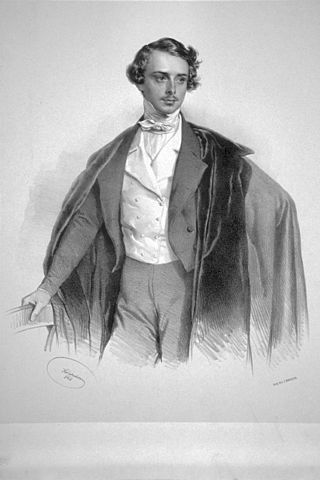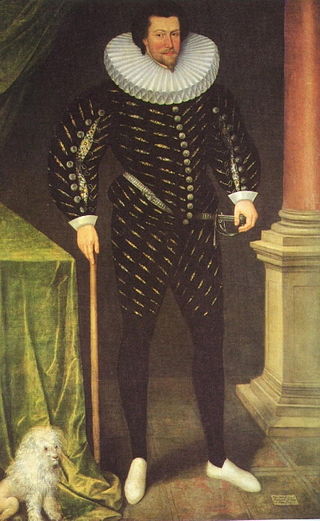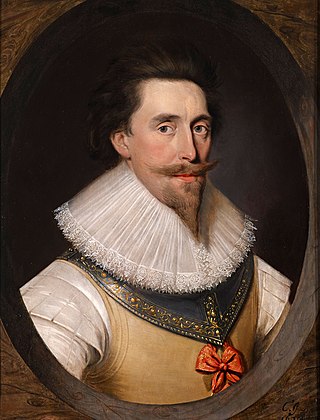
Robert Carr, 1st Earl of Somerset, was a politician, and favourite of King James VI and I.

William Longespée, 3rd Earl of Salisbury was an Anglo-Norman nobleman, primarily remembered for his command of the English forces at the Battle of Damme and for remaining loyal to his half-brother, King John. His nickname "Longespée" is generally taken as a reference to his great physical height and the oversize weapons that he used.

Duke of Bedford is a title that has been created six times in the Peerage of England. The first and second creations came in 1414 and 1433 respectively, both in favour of Henry IV's third son, John, who later served as regent of France. He was made Earl of Kendal at the same time and was made Earl of Richmond later the same year. The titles became extinct on his death in 1435. The third creation came in 1470 in favour of George Neville, nephew of Warwick the Kingmaker. He was deprived of the title by Act of Parliament in 1478. The fourth creation came in 1478 in favour of George, the third son of Edward IV. He died the following year at the age of two. The fifth creation came in 1485 in favour of Jasper Tudor, half-brother of Henry VI and uncle of Henry VII. He had already been created Earl of Pembroke in 1452. However, as he was a Lancastrian, his title was forfeited between 1461 and 1485 during the predominance of the House of York. He regained the earldom in 1485 when his nephew Henry VII came to the throne and was elevated to the dukedom the same year. He had no legitimate children and the titles became extinct on his death in 1495.

Francis Russell, 2nd Earl of Bedford, KG of Chenies in Buckinghamshire and of Bedford House in Exeter, Devon, was an English nobleman, soldier, and politician. He was a godfather to the Devon-born sailor Sir Francis Drake. He served as Lord Lieutenant of Devon (1584-5).

Francis Russell, 4th Earl of Bedford PC was an English nobleman and politician. He built the square of Covent Garden, with the piazza and church of St. Paul's, employing Inigo Jones as his architect. He is also known for his pioneering project to drain The Fens of Cambridgeshire.
William Russell may refer to:

John Romilly, 1st Baron Romilly PC, known as Sir John Romilly between 1848 and 1866, was an English Whig politician and judge. He served in Lord John Russell's first administration as Solicitor-General from 1848 to 1850 and as Attorney-General from 1850 and 1851. The latter year he was appointed Master of the Rolls, a post he held until 1873. Knighted in 1848, he was ennobled as Baron Romilly in 1866.

This is a list of people who have served as Lord Lieutenant of Cambridgeshire. The title Lord Lieutenant is given to the British monarch's personal representative in the counties of the United Kingdom. Lord Lieutenants are supported by an appointed Vice Lord Lieutenant and Deputy Lieutenants. Since 1715, all Lord Lieutenants have also been Custos Rotulorum of Cambridgeshire.

Odo William Leopold Russell, 1st Baron Ampthill,, styled Lord Odo Russell between 1872 and 1881, was a British diplomat and the first British Ambassador to the German Empire.

The Rt Hon. Arthur Grey, 14th Baron Grey de Wilton, KG (1536–1593), was a baron in the Peerage of England. Lord Grey de Wilton is now largely remembered for his memoir of his father, for participating in the last defence of Calais (1558), and for his involvement in the massacre after the Siege of Smerwick (1580) on Corca Dhuibhne in County Kerry. He served as Lord Deputy of Ireland from 1580 until 1582.

Baron Russell of Thornhaugh is a title in the Peerage of England. It was created in 1603 for the English military leader, the Honourable Sir William Russell. He was the fourth son of Francis Russell, 2nd Earl of Bedford. His son succeeded as Earl of Bedford in 1627 and the barony has been united with the earldom ever since.
Lord Russell is a form of address used for several different members of the English family of Russell, including:

Francis Fane, 1st Earl of Westmorland, of Mereworth in Kent and of Apethorpe in Northamptonshire was an English landowner and politician who sat in the House of Commons between 1601 and 1624 and then was raised to the Peerage as Earl of Westmorland.

John Harington, 1st Baron Harington of Exton in Rutland, was an English courtier and politician.
Sir James Harington of Exton was a 16th-century English public servant who fulfilled a number of legal, legislative and law enforcement duties and was knighted in 1565.

Thornhaugh is a civil parish and village in the city of Peterborough unitary authority, Cambridgeshire in the United Kingdom. For electoral purposes the parish forms part of the Glinton and Wittering ward and is in the North West Cambridgeshire constituency. It was formerly in the Soke of Peterborough.

Arthur Chichester, 1st Baron Chichester, of Carrickfergus in Ireland, was an English administrator and soldier who served as Lord Deputy of Ireland from 1605 to 1616. He was instrumental in the development and expansion of Belfast, now Northern Ireland's capital. Several streets are named in honour of himself and his nephew and heir Arthur Chichester, 1st Earl of Donegall, including Chichester Street and the adjoining Donegall Place, site of the Belfast City Hall.

Roger North, 2nd Baron North was an English peer and politician at the court of Elizabeth I.

Sir Charles Morrison was an English politician in the reign of Queen Elizabeth I and heir to the Estate of Cassiobury in Watford, Hertfordshire. He sat in the Parliament of England as MP for Tavistock.

St Michael's Church at Chenies, Buckinghamshire, is a Grade I listed Anglican parish church in the Diocese of Oxford in England. It is not of great architectural interest but stands in an attractive position in the Chess Valley near the Chenies Manor House. The church is famous for its Bedford Chapel, the mausoleum of the Russell family which is private and not open to the public.

















